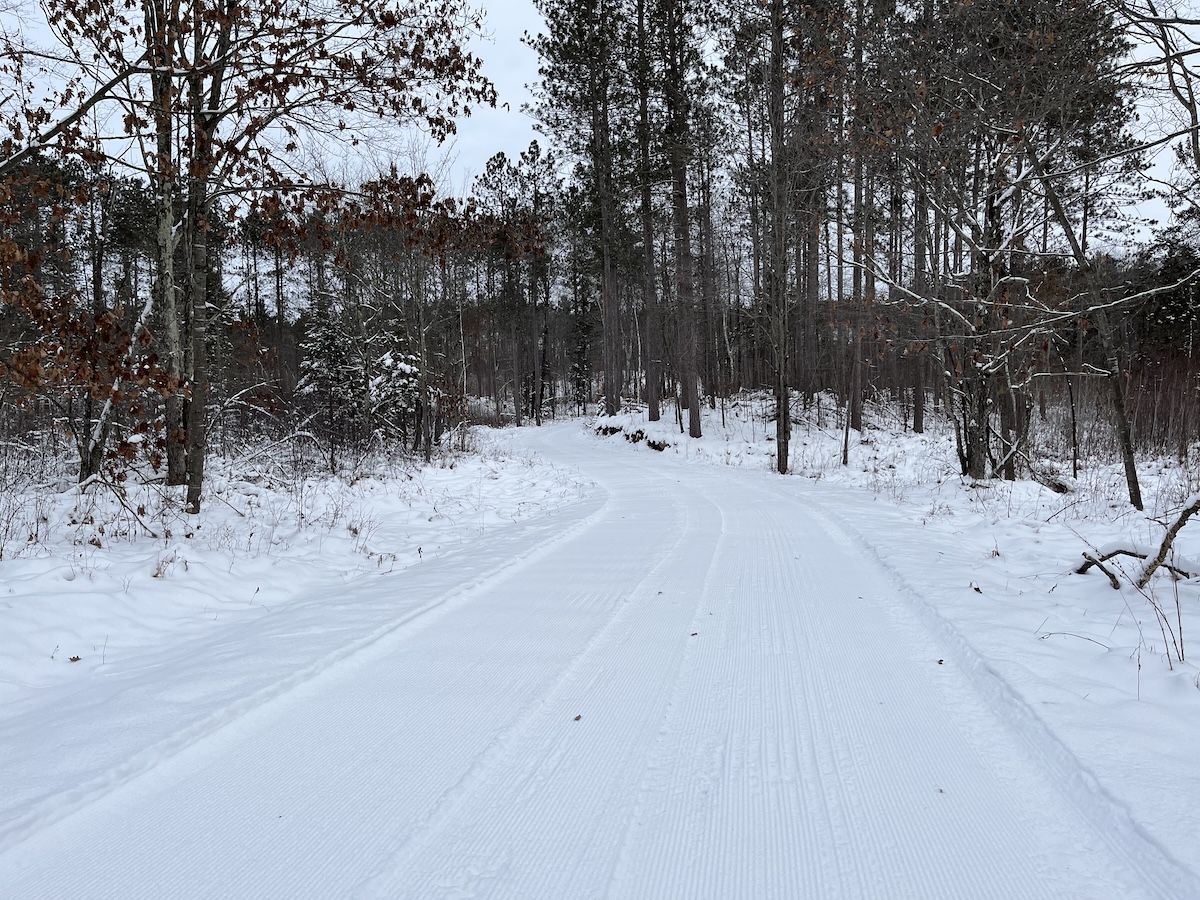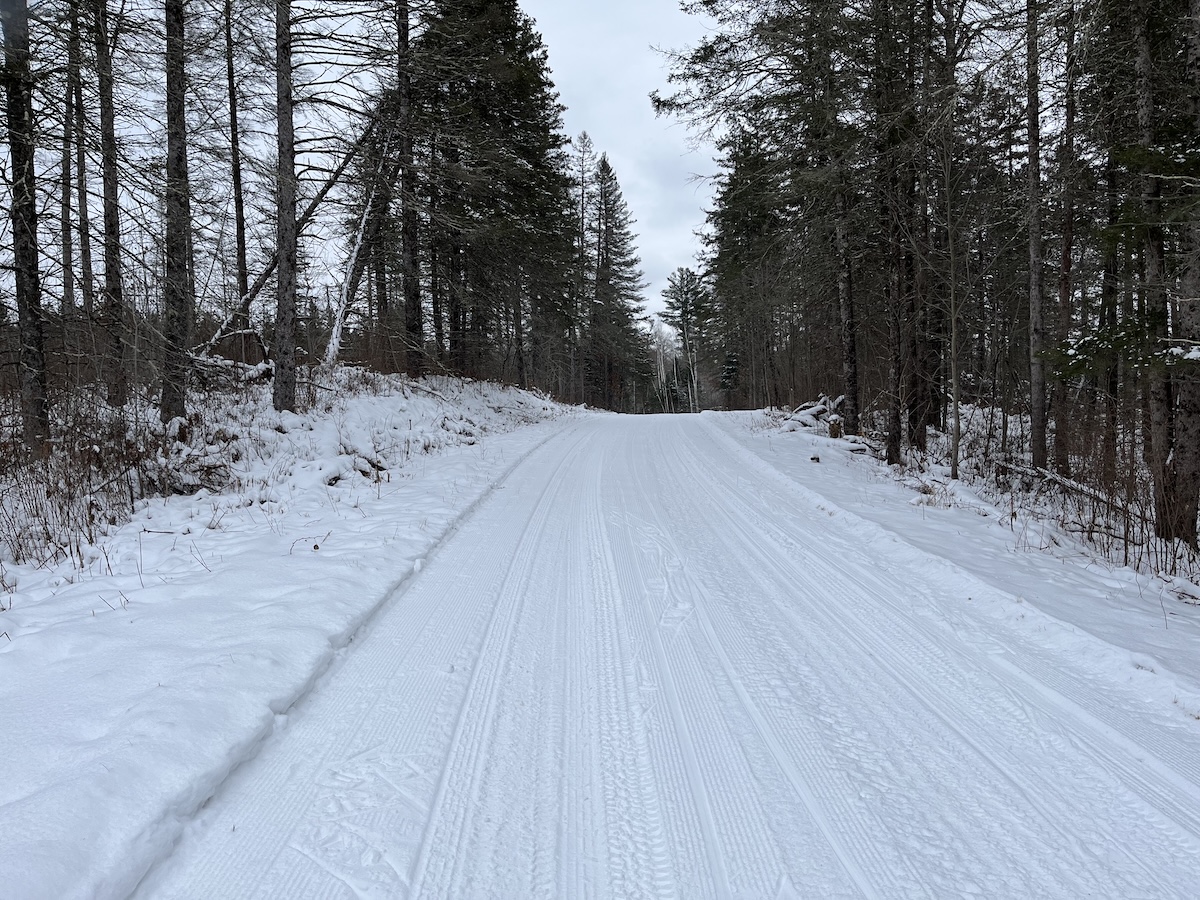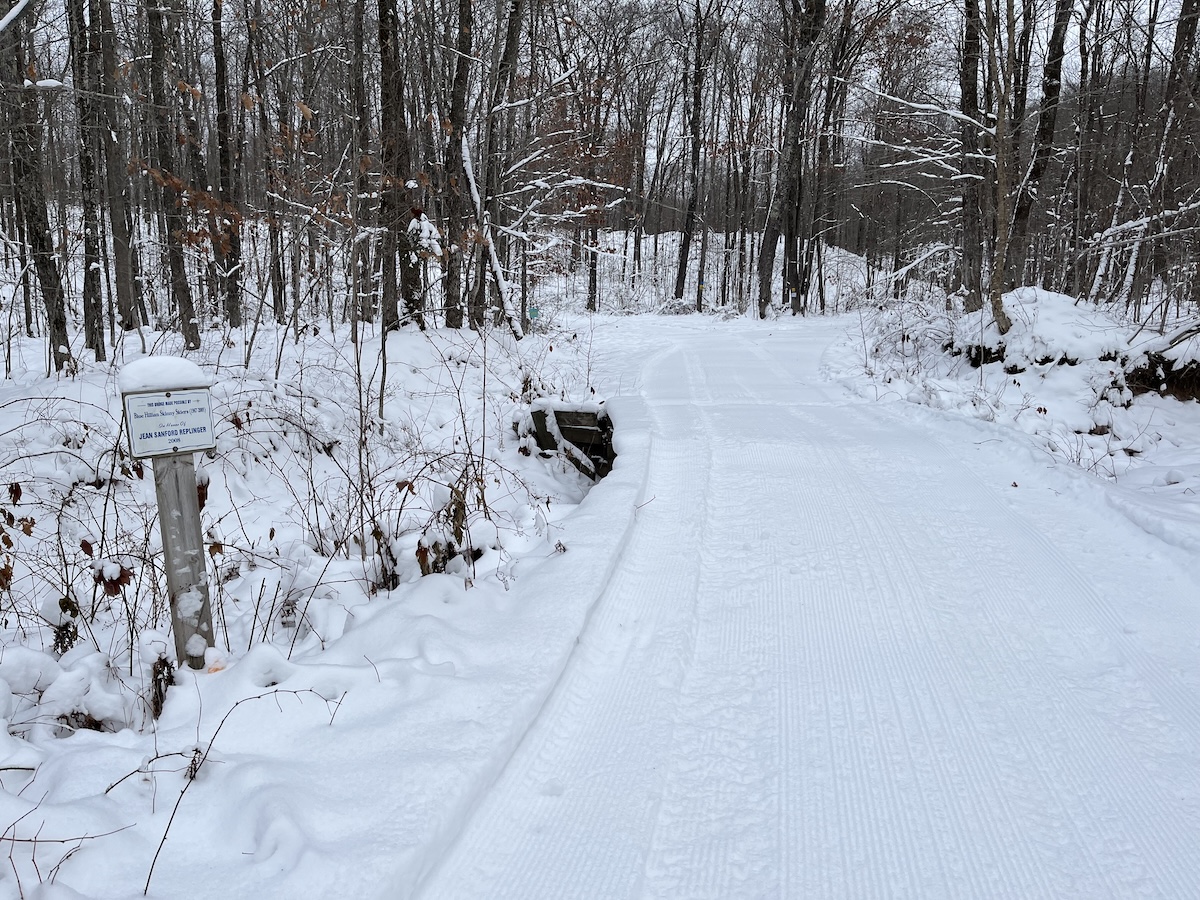grooming
After two winters (2023-24 & 2024-25) that were oh so disappointing, we now have the polar opposite - an early start to winter. With 6+ inches of fairly dense snow the past week, grooming was initiated the afternoon of Sunday, November 30th. More grooming was performed the evening of Monday, December 1st; and again midday on Tuesday, December 2nd. This early season grooming has been limited to the use of a roller/comb to produce a corduroy surface. The goal is to knock the air out of the snow, allow cold temps to penetrate and freeze the underlying trail surface, and create a skiable corduroy surface.
Points worth noting...
- The heat's on in the warming house. Enjoy :-)
- With 6-7 inches of workable snow, a roller was used to groom (pack) the snow and create a corduroy surface on all the East Side trails the past few days. The Core Loop is the firmest, the other side trails on the East Side are softer but certainly skiable. Beginning with 6-7 inches of workable snow, the grooming created pretty good cover of the grasses, rocks, etc. The groomed trails have a 1"-2" thick base. Use your ''rock skis' or 'B skis' until there's a deeper base.
- There's not enough snow to set a classic track. But there's decent striding without a formal track. Typical of early season skiing, the surface is irregular and you need to approach downhills with extra caution.
- During the past 6 months, we've spent a lot of money (~ $60,000!) upgrading our equipment. And a lot of time prepping the trails for skiing. Please support us by taking out a membership and/or donating. If unsure of your current status, click here for a list of our current members.
- Remember to wear blaze orange during the remaining December deer hunts (muzzleloader season is December 1-10; antlerless hunt is December 11-14). There usually aren't a lot of hunters in the woods during the next 2 weeks, but please play it safe.
- Our snowshoe trails await you. Folks have been out stomping the snow already.






Winter. Welcome Back, Don't Be A Stranger.
At last -- a few days of fantastic skiing! This winter (2024-25) started late, was far too dry, and now is ending early. Hurry back my friend, but try to be on time.
Cross country ski conditions this morning (Sunday, February 23rd) were fantastic on the Blue Hills Trail in northwest Wisconsin. Temps started at 23 degrees F, rose above freezing for the first time in 3 weeks, and later in the day hit the low 40s. During the past week, timely grooming of the packed powder and sugar snow surfaces made for wonderful skate or classic skiing this morning before the predicted warmup moved in later in the day. Quite a contrast to the minus 30F windchills a few days earlier.
Enjoy the following photos showing the beauty of the Blue Hills Trail cross country ski trails in northwest Wisconsin -- taken February 21 - 23 (2025). As lovely as the pictures are, the skiing was even better. Right click the photos to open in a new window and enjoy the full size image.
If you'd like to help offset our expenses, follow this link for donations and annual memberships.







January 17th: it's been another very dry start to this winter of 2024-25. 4" of snow prior to Christmas 2024 before that disappeared during a rainy warmup; and only 3+ inches since. Here's a link to 25 years of local snowfall reports.
The 3+ inches of snow that fell January 12th made our groomers happy. They gave it a try, and rolled (packed) the East Side of the trail system, creating a corduroy surface. Unfortunately, there wasn't a lot of moisture in that snow, and the resultant base is very thin. Most of the groomed trails have grasses showing, and underlying rocks or dirt spots that might catch your skis. But NOTE: we're lucky to have one short section of trail that is offering 'OK' skiing: the 'Gravel Road' has just enough base to conceal most of the rocks. On the East Side map, this is the section from 1-2-3-4 plus a 1/2 km beyond intersection #4. Be sure to use your rock skis on any of the trails, and use extra caution knowing that it's likely you'll find an occasional rock that can throw your balance.
The West Side trails are ungroomed and have about 3 inches of snow that you can explore. Once again, be aware that there is no underlying base -- so it's likely you'll discover some hidden rocks and dirt spots. Enjoy the little snow we have. And hope for a nice snowfall in the near future.


We're trying to make the best of a warm, dry winter (2023-24) at the Blue Hills Trail in northern Wisconsin.
November and December were disappointing months for those of us that enjoy winter. To top off the record high temps in December, Christmas was wet (1.5" rainfall) and the ground was bare. Finally in early January some cooler weather moved in, and by mid month we counted several snowfalls amounting to 6 inches. Just enough to groom our 20+ miles of ski trails -- and enough to entice folks to break out their snowshoes and their 'rock' skis.
The warming house has been quiet at a time of year it's usually overflowing with smiling faces. But at least for now we have a little taste of winter.
The following photos show conditions during a week of cold temps in the middle of January. Catch it while you can, the weatherman predicts another blast of hot air.














Winter 2021-22 was a roller coaster weather ride. The thrills really took off with the 14-inch snowfall on December 10th. On December 11th our groomers worked 20 hours and skiers enjoyed really nice conditions -- for a couple days. But a few days later record warm temps were accompanied by rain and tornadic winds, and almost all that snow disappeared by December 15th. How cruel!!!
Just after Christmas, wintry weather returned, and we had decent skiing conditions by New Years. The rest of the winter, temps fluctuated between subzero cold and temps in the teens and twenties. Precipitation often was in the form of dry snow. Following that nasty rain event in mid December, it didn't rain again until March 5th. As a result, we experienced good skiing without icy conditions for most of the winter - pretty unusual.
We groomed a total of 49 times this past winter. Here’s the breakdown: 13 times in December, 16 times in January, 17 times in February, and 3 times in March. Our groomers worked approximately 350 hours during that time. Much of the grooming was in the dark of night, during cold temps, and challenging weather. Hats off to our groomers!
Overall, it was a fairly long winter with very good skiing and snowshoeing in the Blue Hills. Good skiing lasted until mid March. The last grooming of the season on March 19th created rocket fast conditions on the East Side Core Loop, a great way to say goodbye to winter. We hope the following photos trigger some good memories.
































Weather forecasters predicted a narrow band of heavy snow for northwest Wisconsin. For our area, we were hoping for a nice 4" snowfall to add to our early season thin base. As the storm moved in, late the evening of Friday (December 10th) we measured 7", and awoke Saturday to snow accumulations guesstimated at 14"-18" in the vicinity of the Blue Hills Trail. WooHoo! Biggest snowfall in YEARS! First double digit snowfall since a 10-inch snowfall November 10, 2014.
At that point, the grooming challenge begins for two tough guys: fight your way to the trailhead while the snowplows are out working the main highways; use our Honda Pioneer UTV and Arctic Cat Bearcat to bust through the deep snow as you start to open some select trails; return home for a change of dry clothes; come to the rescue of the local plow operator when his big snowplow truck got stuck in the ditch near the trailhead; grab some hot food from town (10 miles away) because the grooming wouldn't end anytime soon; deal with dry slick snow that made it difficult for the grooming machines to climb the hills without the tracks slipping (note: there are lots of hills in the Blue Hills); burn up gas like it's going out of style; stop and remove snow sticking to the rollers; after sunset enjoy the clear skies and a winter wonderland. And hope skiers the following day would appreciate your efforts.
Just a couple weeks ago we were out hiking bare ground. Skiers on Sunday (December 12th) enjoyed a wintry wonderland. The select trails that were groomed on the 11th weren't in top shape, but they provided loads of fun. The 14" snowfall (dry snow!) compressed into a 2" base that was thick enough to allow the use of good skis. Sure, skiing wasn't perfect today, but who's complaining? Take a look at the following photos of happy skiers as we begin winter 2021-2022.













The many acres of trails on the West Side of the Blue Hills Trail are often home to beavers. In years past, we've been able to tolerate a few of their permanent dams while trying to maintain the adjacent trails in the summer, and groom next to their dams in the winter.
Sad to say, too often we've resorted to trapping to remove 'nuisance beavers' (we report the problems to the County Forestry Department, and they hire out the work to a professional trapper).
All summer we've observed an active 200-foot long beaver dam that is located next to the ski trail (between intersections I and H), with about 130 feet of the trail wet enough to perhaps make it difficult to groom and ski this winter. Instead of trapping out the beavers at this spot, we decided to try a different approach. We'd like to learn how to coexist.
The first photo (below) shows this location in early September. See the small bridge? Beyond the bridge the trail has water slowly moving over the trail. We've debated various options, and yesterday (November 13th) decided to install a small beaver deceiver (pond leveler) device.
Here's what Sam, Benny, and Tom did...
· Purchased five 10-foot lengths of 4" corrugated HDPE pipe ('drain tile') and one filter
· Breached the beaver dam with the goal of dropping the water level about two feet
· Screwed the pipe sections together, and fastened the filter on the upstream end
· Drilled holes in the first 20 feet of pipe (to allow trapped air to escape)
· Attached a weight five feet from the upstream end (to hold the pipe underwater)
· Waded into the pond with the upstream end of the pipe (and the weight)
· Placed the downstream end of pipe (30 feet in length) through the breach in the beaver dam, and under the bridge on the ski trail
· Dropped the upstream end (and weight) into water that was probably five feet deep
· Placed a vertical wood post in the breach of the dam, and attached the pipe to that post
· Confirmed a nice volume of water flowing through the downstream end of the pipe
The materials cost about $30. We’re hoping the beavers quickly show up and repair the breach in the beaver dam. This hopefully would seal the pipe into the dam at a height that will control the water level – leaving enough water for the beavers to use the pond, but keeping the water level low enough to minimize the tendency for water to leak through the dam and flow over the ski trail.
We learned a lot from this first attempt at installing a pond leveling device. It was a nice muddy day playing in the beaver habitat, here’s hoping we can coexist.







Our new workhorse has arrived!
After selling our 2014 Gator to a private party, in early April we finalized plans to purchase and modify a 2020 Honda Pioneer 1000 Deluxe side-by-side that now makes its home at the Blue Hills Trail.
Beginning in February, recognizing it was time to replace our Gator, here's the process we followed...
- Researched UTVs that would meet our needs
- Researched industrial strength tracks that would be superior to the Camoplast tracks we've used since 2014
- Inspected and test drove several UTVs
- Visited the nearest Mattracks dealer (Winter, WI) for a first hand look
- Spoke with groomers at ski trails with experience using the Honda Pioneer, and Mattracks.
By late March, we felt the Honda Pioneer 1000 was a good choice for our new UTV. And Mattracks became our choice for a tougher set of tracks. Recognizing the need to pay attention to our space limitations (the doors opening into our storage shed are 83" wide and 83" tall), we...
- Downloaded specs for Mattracks and the Pioneer
- Made multiple careful measurements of the Pioneer
- Realizing the vertical fit would be close, we decided to purchase the Pioneer (with a backup option of modifying the storage shed doors)
Recognizing the current Coronavirus Pandemic has greatly disrupted supply chains and the availability of manufactured items, we felt fortunate to locate a UTV that could fit our needs (a 2020 Pioneer was available at Zacho Sports Center in Chippewa Falls). We made a down payment on the Pioneer. Simultaneously, we ordered the Mattracks from TRACKIT trail grooming located east of Winter, WI (just before a big price increase). Zacho Sports Center did nice work adding a front receiver hitch, interior storage compartments, front and rear LED lights, special dashboard rocker switches to operate our grooming implements, and a second stronger battery to handle the extra electrical load.
Once all the modifications were completed on the Pioneer, we sealed the deal and chose May 12th as the day to transport the Pioneer from Chippewa Falls to Winter (Wisconsin) where the tracks were installed. Then from there to the Blue Hills Trail -- all in the same day. A HUGE THANK YOU to John Waldron for his time and mileage (220 miles that day) as he trailered from Rice Lake to Chippewa Falls to Winter to our trailhead transporting the Pioneer.
Once at the trailhead, we were relieved our new Pioneer fit the vertical opening into the storage shed with about 3 inches to spare! WooHoo!!!
The next major step was to fabricate a special extended rear hitch for towing our grooming implements and trail mower. Bob Wieckowicz (our member with special welding expertise) evaluated the Pioneer, and decided to weld the extended hitch at his shop. The welding and painting was accomplished in a couple days, and the Pioneer returned to the trailhead just before rainy weather moved in. Considering the tight spaces that are present when the cargo bed is tilted, the fabricated hitch and welding support is really quite brilliant! Thanks Bob!
Many thanks to the following members that helped research the new machine and tracks: Sam Behrends, Ron Beebe, Ron Jasperson, Tom Paulsen, and John Waldron. And thanks to Bob Langer for help with trailering as part of the rear hitch fabrication.
And many thanks to our members and donors. The Pioneer + Mattracks is a big investment, we genuinely appreciate your financial support.










Post Categories
Blue Hills Trail
instagram updates
Subscribe to Newsletter Updates
Stay in-the-know about grooming updates, special events, news, announcements, volunteer days, and more. Rest-assured, we never sell or share your information.


